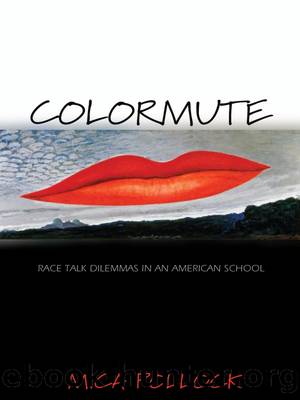Colormute by Pollock Mica;

Author:Pollock, Mica;
Language: eng
Format: epub
Publisher: Princeton University Press
Conclusion
In our schools and districts, everyday analysts are faced with the daunting task of analyzing how race matters to the opportunity to succeed, one of the most complex analytic and political questions facing academic and legal analysts as well. In California City schools, daily life indeed raised some paralyzing questions. Were all students in a mostly low-income, non-white district or school equally “needy”?Which populations, if any, were to be targeted for extra assistance? And finally, if assistance targeting racial subgroups was deemed necessary, how were people supposed to accomplish and justify such assistance within multiracial and class-diverse communities?
No one at “low-income minority” Columbus, where hardly any student was both “well-off” and “white,” could argue that “race” was totally irrelevant to the school’s disadvantaged status within the district. Indeed, no one ever did. Throughout California City, however—as in the state of California at large—debate over defining and addressing complex racial patterns in educational inequality routinely concluded simplistically that racial analyses of inequality were inherently inaccurate. In our confusion over how race matters to “disadvantage,” and over how race should then matter to remedying “disadvantage,” Americans often end up discarding the possibility of any sophisticated analysis of inequalities that are both racial and economic. Indeed, as we fail routinely to describe accurately the complex dynamics of our existing inequalities, we are choosing more and more not to analyze our inequalities at all.
As U.S. school districts become more and more diverse, our confusions are multiplying: we have little guidance in theorizing remedies for inequalities that are simultaneously binary and multiracial. Columbus offered innumerable snarly examples of such complex disadvantage. “Filipinos” at Columbus, for example—framed sometimes in research as California’s most “disadvantaged” Asians (Kitano and Daniels 1988)—stood on a bizarre borderline between perceived advantage and disadvantage: many Columbus people described the school’s “Filipinos,” who were low income but lived in housing projects far more rarely than the school’s “blacks” and “Samoans,” as relatively well-off. As a self-described “Latin” student put it once, “Filipino kids” in the Columbus neighborhood often seemed to go to a more prestigious public school or even to private school because of “money.” Sitting with me and one of her friends one day in 1998, Tina, a graduated student who described herself as “black,” predicted that no “black people” would likely be going to any future Columbus reunions: it would be “all Filipinos,” she said, people who had graduated and done things they were proud to come back and report on. Truly, at the 1997 Columbus graduation ceremony, the huge majority of students walking down the aisle in their caps and gowns were “Filipinos”; and far more of them were heading immediately to college than any other Columbus “group.” Some inequality—some racial and possibly race-class inequality—was taking its toll within this low-income, kids-of-color community. But how is one to analyze and remedy an inequality this complex, especially without suggesting that Filipino students graduating from a low-tracked, underresourced school for discarded “rejects” had somehow gotten a good deal?
As our city schools and
Download
This site does not store any files on its server. We only index and link to content provided by other sites. Please contact the content providers to delete copyright contents if any and email us, we'll remove relevant links or contents immediately.
| African-American Studies | Asian American Studies |
| Disabled | Ethnic Studies |
| Hispanic American Studies | LGBT |
| Minority Studies | Native American Studies |
Cecilia; Or, Memoirs of an Heiress — Volume 1 by Fanny Burney(31333)
Cecilia; Or, Memoirs of an Heiress — Volume 3 by Fanny Burney(30934)
Cecilia; Or, Memoirs of an Heiress — Volume 2 by Fanny Burney(30889)
The Great Music City by Andrea Baker(21313)
We're Going to Need More Wine by Gabrielle Union(18073)
Bombshells: Glamour Girls of a Lifetime by Sullivan Steve(13108)
Pimp by Iceberg Slim(12931)
All the Missing Girls by Megan Miranda(12748)
Fifty Shades Freed by E L James(12451)
Norse Mythology by Gaiman Neil(11883)
Talking to Strangers by Malcolm Gladwell(11877)
Crazy Rich Asians by Kevin Kwan(8349)
Mindhunter: Inside the FBI's Elite Serial Crime Unit by John E. Douglas & Mark Olshaker(7834)
The Lost Art of Listening by Michael P. Nichols(6474)
Enlightenment Now: The Case for Reason, Science, Humanism, and Progress by Steven Pinker(6405)
Bad Blood by John Carreyrou(5769)
The Four Agreements by Don Miguel Ruiz(5511)
Weapons of Math Destruction by Cathy O'Neil(5037)
We Need to Talk by Celeste Headlee(4869)
